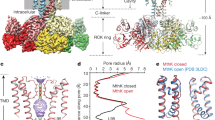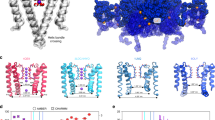Abstract
Ion channels exhibit two essential biophysical properties; that is, selective ion conduction, and the ability to gate-open in response to an appropriate stimulus. Two general categories of ion channel gating are defined by the initiating stimulus: ligand binding (neurotransmitter- or second-messenger-gated channels) or membrane voltage (voltage-gated channels). Here we present the structural basis of ligand gating in a K+ channel that opens in response to intracellular Ca2+. We have cloned, expressed, analysed electrical properties, and determined the crystal structure of a K+ channel (MthK) from Methanobacterium thermoautotrophicum in the Ca2+-bound, opened state. Eight RCK domains (regulators of K+ conductance) form a gating ring at the intracellular membrane surface. The gating ring uses the free energy of Ca2+ binding in a simple manner to perform mechanical work to open the pore.
This is a preview of subscription content, access via your institution
Access options
Subscribe to this journal
Receive 51 print issues and online access
$199.00 per year
only $3.90 per issue
Buy this article
- Purchase on Springer Link
- Instant access to full article PDF
Prices may be subject to local taxes which are calculated during checkout








Similar content being viewed by others
References
Hille, B. Ion Channels of Excitable Membranes (Sinauer, Sunderland, Massachusetts, 2001)
Zhou, Y., Morais-Cabral, J. H., Kaufman, A. & MacKinnon, R. Chemistry of ion coordination and hydration revealed by a K+ channel–Fab complex at 2.0 Å resolution. Nature 414, 43–48 (2001)
Morais-Cabral, J. H., Zhou, Y. & MacKinnon, R. Energetic optimization of ion conduction rate by the K+ selectivity filter. Nature 414, 37–42 (2001)
Doyle, D. A. et al. The structure of the potassium channel: molecular basis of K+ conduction and selectivity. Science 280, 69–77 (1998)
Sigworth, F. J. Voltage gating of ion channels. Q. Rev. Biophys. 27, 1–40 (1994)
Bezanilla, F. The voltage sensor in voltage-dependent ion channels. Physiol. Rev. 80, 555–592 (2000)
Zagotta, W. N. & Siegelbaum, S. A. Structure and function of cyclic nucleotide-gated channels. Annu. Rev. Neurosci. 19, 235–263 (1996)
Finn, J. T., Grunwald, M. E. & Yau, K. W. Cyclic nucleotide-gated ion channels: an extended family with diverse functions. Annu. Rev. Physiol. 58, 395–426 (1996)
Schreiber, M. & Salkoff, L. A novel calcium-sensing domain in the BK channel. Biophys. J. 73, 1355–1363 (1997)
Xia, X. M. et al. Mechanism of calcium gating in small-conductance calcium-activated potassium channels. Nature 395, 503–507 (1998)
Jiang, Y., Pico, A., Cadene, M., Chait, B. T. & MacKinnon, R. Structure of the RCK domain from the E. coli K+ channel and demonstration of its presence in the human BK channel. Neuron 29, 593–601 (2001)
Sack, J. S., Saper, M. A. & Quiocho, F. A. Periplasmic binding protein structure and function. Refined X-ray structures of the leucine/isoleucine/valine-binding protein and its complex with leucine. J. Mol. Biol. 206, 171–191 (1989)
Zou, J. Y., Flocco, M. M. & Mowbray, S. L. The 1.7 Å refined X-ray structure of the periplasmic glucose/galactose receptor from Salmonella typhimurium. J. Mol. Biol. 233, 739–752 (1993)
Bjorkman, A. J. et al. Probing protein-protein interactions. The ribose-binding protein in bacterial transport and chemotaxis. J. Biol. Chem. 269, 30206–30211 (1994)
Bellamacina, C. R. The nicotinamide dinucleotide binding motif: a comparison of nucleotide binding proteins. FASEB J. 10, 1257–1269 (1996)
Schlosser, A., Hamann, A., Bossemeyer, D., Schneider, E. & Bakker, E. P. NAD+ binding to the Escherichia coli K(+)-uptake protein TrkA and sequence similarity between TrkA and domains of a family of dehydrogenases suggest a role for NAD+ in bacterial transport. Mol. Microbiol. 9, 533–543 (1993)
Miller, C., Moczydlowski, E., Latorre, R. & Phillips, M. Charybdotoxin, a protein inhibitor of single Ca2+-activated K+ channels from mammalian skeletal muscle. Nature 313, 316–318 (1985)
MacKinnon, R. & Miller, C. Mutant potassium channels with altered binding of charybdotoxin, a pore-blocking peptide inhibitor. Science 245, 1382–1385 (1989)
Moczydlowski, E. & Latorre, R. Gating kinetics of Ca2+-activated K+ channels from rat muscle incorporated into planar lipid bilayers. Evidence for two voltage- dependent Ca2+ binding reactions. J. Gen. Physiol. 82, 511–542 (1983)
Vergara, C. & Latorre, R. Kinetics of Ca2+-activated K+ channels from rabbit muscle incorporated into planar bilayers. Evidence for a Ca2+ and Ba2+ blockade. J. Gen. Physiol. 82, 543–568 (1983)
Cox, D. H., Cui, J. & Aldrich, R. W. Separation of gating properties from permeation and block in mslo large conductance Ca-activated K+ channels. J. Gen. Physiol. 109, 633–646 (1997)
Jiang, Y. et al. The open pore conformation of potassium channels. Nature 417, 523–526 (2002)
Mayer, M. L., Olson, R. & Gouaux, E. Mechanisms for ligand binding to GluR0 ion channels: crystal structures of the glutamate and serine complexes and a closed apo state. J. Mol. Biol. 311, 815–836 (2001)
Armstrong, N., Sun, Y., Chen, G. Q. & Gouaux, E. Structure of a glutamate-receptor ligand-binding core in complex with kainate. Nature 395, 913–917 (1998)
Golowasch, J., Kirkwood, A. & Miller, C. Allosteric effects of Mg2+ on the gating of Ca2+-activated K+ channels from mammalian skeletal muscle. J. Exp. Biol. 124, 5–13 (1986)
Cadene, M. & Chait, B. T. A robust, detergent-friendly method for mass spectrometric analysis of integral membrane proteins. Anal. Chem. 72, 5655–5658 (2000)
Cohen, S. L. & Chait, B. T. Mass spectrometry as a tool for protein crystallography. Ann. Rev. Biophys. Biomol. Struct. 30, 67–85 (2001)
Otwinowski, Z. & Minor, W. Processing of X-ray diffraction data collected in oscillation mode. Methods Enzymol. 276, 307–326 (1997)
Terwilliger, T. C. & Berendzen, J. Automated MAD and MIR structure solution. Acta Crystallogr. D 55 4, 849–861 (1999)
Weeks, C. M. & Miller, R. The design and implementation of SnB version 2.0. J. Appl. Cryst. 32, 120–124 (1999)
Collaborative Computational Project No. 4 The CCP4 suite: programs for X-ray crystallography. Acta Crystallogr. D 50, 760–763 (1994)
de La Fortelle, E. & Bricogne, G. Maximum-likelihood heavy-atom parameter refinement for multiple isomorphous replacement and multiwavelength anomalous diffraction methods. Methods Enzymol. 276, 472–494 (1997)
Abrahams, J. P. & Leslie, A. G. W. Methods used in the structure determination of bovine mitochondrial F1 ATPase. Acta Crystallogr. D 52, 30–42 (1996)
Cowtan, K. Modified phased translation functions and their application to molecular-fragment location. Acta Crystallogr. D 54 5, 750–756 (1998)
Kleywegt, G. J. & Jones, T. A. in From the First Map to Final Model Proceedings of the CCP4 study weekend (eds Bailey, S., Hubbard, R. & Waller, D.) 59–66 (Daresbury Laboratory, Daresbury, 1994)
Jones, T. A., Zou, J. Y., Cowan, S. W. & Kjeldgaard, M. Improved methods for building protein models in electron density maps and the location of errors in these models. Acta Crystallogr. A 47, 110–119 (1991)
Brunger, A. T. et al. Crystallography & NMR system: a new software suite for macromolecular structure determination. Acta Crystallogr. D 54, 905–921 (1998)
Heginbotham, L., LeMasurier, M., Kolmakova-Partensky, L. & Miller, C. Single streptomyces lividans K+ channels. Functional asymmetries and sidedness of proton activation. J. Gen. Physiol. 114, 551–560 (1999)
Carson, M. Ribbons. Methods Enzymol. 277, 493–505 (1997)
Nicholls, A., Sharp, K. A. & Honig, B. Protein folding and association: insights from the interfacial and thermodynamic properties of hydrocarbons. Proteins 11, 281–296 (1991)
Esnouf, R. M. An extensively modified version of MolScript that includes greatly enhanced coloring capabilities. J. Mol. Graph. Model. 15, 132–133 (1997)
Acknowledgements
We thank the staff at the NSLS, Brookhaven National Laboratory, X-25, Cornell High Energy Synchrotron Source, F1 and ALS, Lawrence Berkeley Laboratory, 5.0.2 for synchrotron support; members of the MacKinnon laboratory, P. Model and M. Russel for discussion; C. Miller and D. Gadsby for critical reading of the manuscript; and W. Chin for help in manuscript preparation. This work was supported by grants from the NIH to R.M. and the National Centre for Research Resources, NIH, to B.T.C. R.M. is an investigator in the Howard Hughes Medical Institute.
Author information
Authors and Affiliations
Corresponding author
Ethics declarations
Competing interests
The authors declare that they have no competing financial interests.
Supplementary information
Rights and permissions
About this article
Cite this article
Jiang, Y., Lee, A., Chen, J. et al. Crystal structure and mechanism of a calcium-gated potassium channel. Nature 417, 515–522 (2002). https://doi.org/10.1038/417515a
Received:
Accepted:
Issue Date:
DOI: https://doi.org/10.1038/417515a
This article is cited by
-
Calcium-gated potassium channel blockade via membrane-facing fenestrations
Nature Chemical Biology (2023)
-
Conformational plasticity of NaK2K and TREK2 potassium channel selectivity filters
Nature Communications (2023)
-
Synthesis of salinity ultra-sensitive ionic hydrogels for visual salinity detection and usage as an intelligent liquid valve
Science China Materials (2023)
-
Structure-guided steric hindrance engineering of Bacillus badius phenylalanine dehydrogenase for efficient l-homophenylalanine synthesis
Biotechnology for Biofuels (2021)
-
Small molecule modulation of the Drosophila Slo channel elucidated by cryo-EM
Nature Communications (2021)
Comments
By submitting a comment you agree to abide by our Terms and Community Guidelines. If you find something abusive or that does not comply with our terms or guidelines please flag it as inappropriate.



